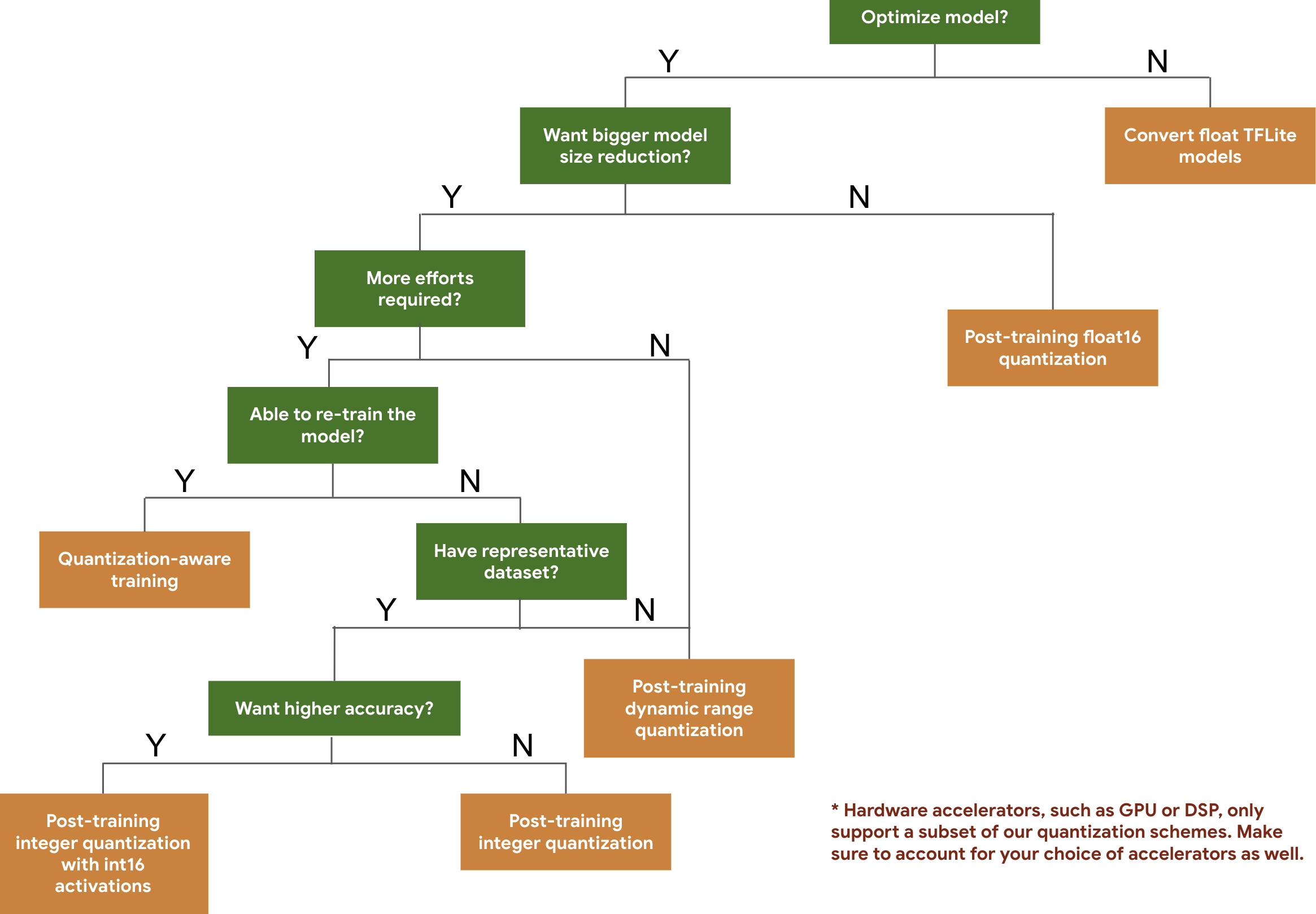TensorFlow Model Quantization
About 2 min
TensorFlow Model Quantization
量化是 TensorFlow 中的一個強大功能,可以在減少模型大小和提高推理速度的同時,將精度損失降到最低。
Why models should be optimized
量化是將浮點數 (如 FP32) 表示的權重和激活函數轉換為更低精度的數據類型 (如 INT8) 的過程。這可以:
- 減少模型大小
- 降低內存和計算需求
- 加速推理速度,尤其在資源受限的設備上(如手機和嵌入式設備)。
Optimization Methods
TensorFlow Lite 提供了多種後訓練量化技術,您可以根據需求選擇適合的技術來優化模型大小與性能。以下是各種量化技術的摘要表:
| Technique | Benefits | Supported Hardware |
|---|---|---|
| Dynamic Range Quantization | - 4x smaller model size - 2x-3x speedup | CPU |
| Full Integer Quantization | - 4x smaller model size - 3x+ speedup | CPU, Edge TPU, Microcontrollers |
| Float16 Quantization | - 2x smaller model size - GPU acceleration | CPU, GPU |
decision tree

實作教學
1. 準備模型
先準備好 TensorFlow 模型(例如 .h5 或 SavedModel 格式)。
import tensorflow as tf
# 加載模型
model = tf.keras.applications.MobileNetV2(weights="imagenet", input_shape=(224, 224, 3))
model.save("mobilenet_v2_saved_model")2. dynamic range quantization
適合對性能和準確性要求不高的應用。
import tensorflow as tf
# 加載 SavedModel
converter = tf.lite.TFLiteConverter.from_saved_model("mobilenet_v2_saved_model")
# 啟用動態範圍量化
converter.optimizations = [tf.lite.Optimize.DEFAULT]
tflite_model = converter.convert()
# 保存量化後的模型
with open("mobilenet_v2_dynamic_range.tflite", "wb") as f:
f.write(tflite_model)3. integer quantization
需要提供校準數據集,讓量化過程計算激活函數的範圍。
def representative_dataset():
for _ in range(100):
# 提供校準數據(例如 224x224 的隨機數據)
yield [tf.random.uniform([1, 224, 224, 3], 0, 255)]
converter = tf.lite.TFLiteConverter.from_saved_model("mobilenet_v2_saved_model")
converter.optimizations = [tf.lite.Optimize.DEFAULT]
converter.representative_dataset = representative_dataset
converter.target_spec.supported_ops = [tf.lite.OpsSet.TFLITE_BUILTINS_INT8]
# 全整數量化(optional) -> 將輸入和輸出設為 int8
# converter.inference_input_type = tf.int8
# converter.inference_output_type = tf.int8
tflite_model = converter.convert()
with open("mobilenet_v2_integer_quant.tflite", "wb") as f:
f.write(tflite_model)4. float16 quantization
import tensorflow as tf
# 加載模型
# 這裡假設您已經有一個 SavedModel 格式的模型
converter = tf.lite.TFLiteConverter.from_saved_model("mobilenet_v2_saved_model")
# 啟用 FP16 優化
converter.optimizations = [tf.lite.Optimize.DEFAULT]
# 設置目標類型為 FP16
converter.target_spec.supported_types = [tf.float16]
# 轉換模型
tflite_fp16_model = converter.convert()
# 保存 FP16 量化模型
with open("mobilenet_v2_fp16.tflite", "wb") as f:
f.write(tflite_fp16_model)5. 測試量化後的模型
使用 TensorFlow Lite 進行推理。
import numpy as np
import tensorflow as tf
# 加載量化模型
interpreter = tf.lite.Interpreter(model_path="mobilenet_v2_full_integer_quant.tflite")
interpreter.allocate_tensors()
# 獲取輸入和輸出的細節
input_details = interpreter.get_input_details()
output_details = interpreter.get_output_details()
# 構建測試數據
input_data = np.random.randint(0, 255, size=(1, 224, 224, 3), dtype=np.uint8)
# 設定輸入
interpreter.set_tensor(input_details[0]['index'], input_data)
# 推理
interpreter.invoke()
# 獲取輸出
output_data = interpreter.get_tensor(output_details[0]['index'])
print("模型輸出:", output_data)常見問題
如何選擇量化方式?
- 資源有限的設備上:使用全整數量化。
- 精度敏感的應用:嘗試動態範圍量化或整數量化。
代表數據集需要多少數據? 通常數百條數據即可,這些數據不需要標籤。
如何檢查模型是否被成功量化? 使用 TensorFlow Lite 的工具檢查模型的權重格式。